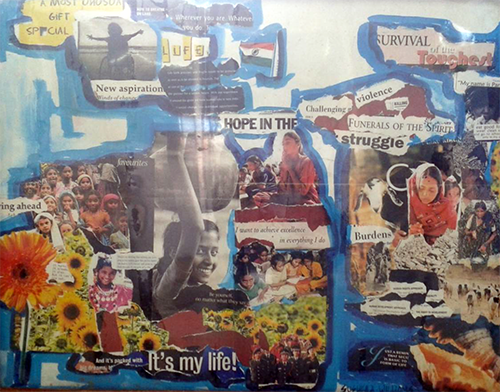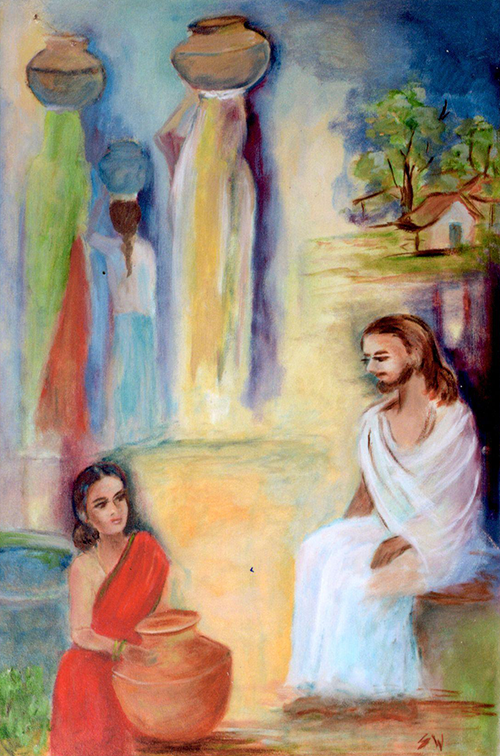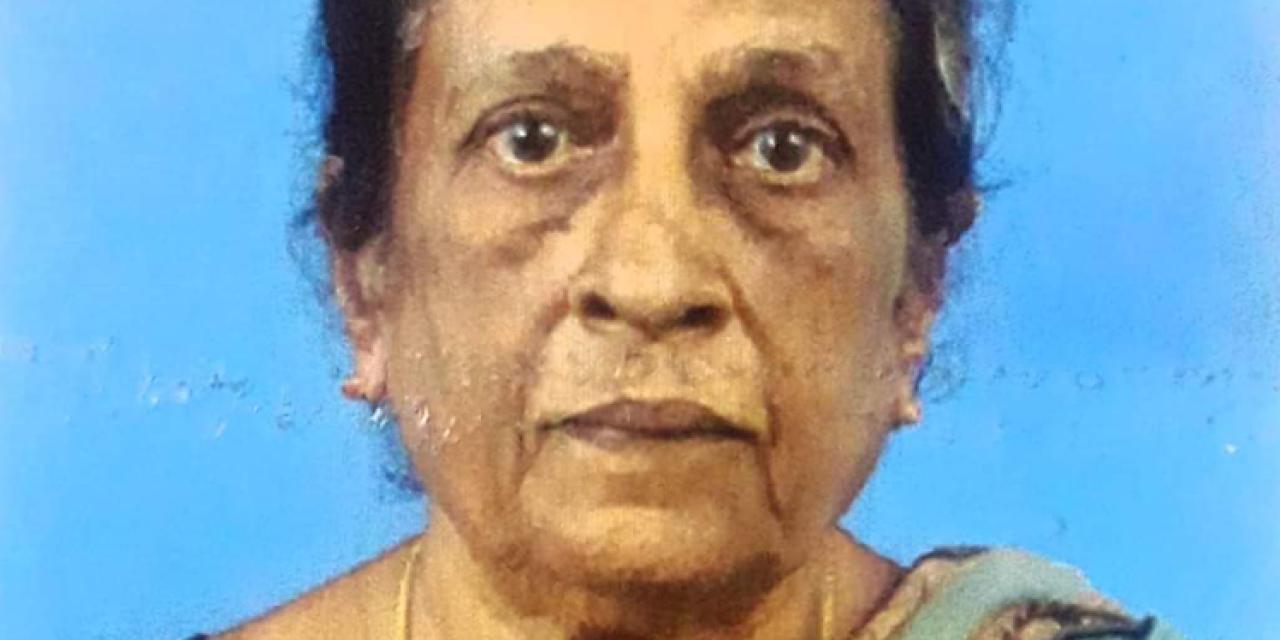Susheila Williams lives out her faith in ways that help Tamil-speaking Christians in South India respond to God in body, mind, heart, and spirit. She draws on the rich ancient traditions of Tamil literature, folklore, visual art, and music to model what it means to walk with Christ in the Indian context.
“Susheila Williams’ personal story is remarkable. Despite her advancing age, she remains an important liaison for our growing network of Christian colleges in India,” says Shirley Roels, executive director of INCHE (once known as IAPCHE), a worldwide network seeking to advance Christian higher education on six continents through professional development, scholarship, capacity building, and communication.
“Susheila is an excellent model of how our INCHE network seeks to reflect both the shared view that Christ is central to our efforts and the local realities where we serve,” Roels adds.
Determined to learn and grow
Williams was ten years old when India gained independence from Britain in 1947. She grew up in in a Christian household in Madurai, the cultural capital of Tamil Nadu, India’s southernmost state. Her father had a government job.
“Though she was a bright child in a missionary middle school, her father did not believe in further education for girls,” Roels says, “but one of the mission teachers insisted that her father give signed permission for her continuing college education.” In a 2011 interview with Kami L. Rice, Williams explained that her father was worried he’d have trouble finding a bridegroom if his daughter had too much education.
After earning a bachelor’s degree in economics, Williams did marry and became the mother of two sons. “When our family was in Delhi,” she says, “I underwent training in oil painting under Mr. Anand Michael, who studied art at University of Michigan.”
When her sons entered professional colleges, she returned to her studies and gradually earned a master’s degree in English literature, a diploma in office organization and procedures, a post-graduate diploma in interior design, a one-year course certification in the teaching of English, and a doctorate in women’s studies.
Meanwhile, she worked as an interior designer, counting major banks among her clients. She also served twelve years as director of a Church of South India (CSI) vocational training center for women, the CSI Secretarial Training Centre in Coimbatore Diocese, Emmanuel Church compound.
Roels explains that Williams joined IAPCHE in the early1990s because of a connection through John B. Hulst, then IAPCHE’s executive director. “Since that time,” Roels says, “she has presented research and scholarship at multiple IAPCHE conferences on many continents and served on our board.”
Promoting education and social outreach

Williams remains interested in serving people from all levels of society, especially women. “She is a deep font of knowledge and support for women’s Christian education in India,” Roels says.
The Church of South India appointed Williams to help with the 1995 founding of CSI Bishop Appasamy College of Arts & Science (BACAS) in Coimbatore, Tamil Nadu. As BACAS’ chief administrative officer, she helped faculty and students connect their studies with social concerns, solidarity, and justice. In this capacity, she also helped establish CSI Bishop Appasamy College of Education in 2012. Meanwhile she ran successful skill development programs for urban and rural women from 1988 to 1998 in 10 villages.
Jan Peter Schouten profiled Williams in his book Jesus as Guru: the Image of Christ Among Hindus and Christians in India. “For many years, she worked as a volunteer in organizing campaigns for social awareness, eliminating illiteracy, and healthcare in a dozen villages,” he writes.
Williams created the collage “Girl Child” to urge activism against female feticide (aborting girls before birth) and infanticide (withholding milk so girls die as infants). Experience shows that advocacy and intervention can help prevent both.
Kami L. Rice blogged about meeting many BACAS students and faculty and accompanying Williams on visits to several BACAS community outreach sites. They went to Coimbatore Central Prison and a children’s home. They also observed a tutoring center for children at risk for dropping out of school and watched a street play put on by BACAS social work students about the dangers of alcoholism.
When Rice asked Williams what she most enjoyed about her role at BACAS, Williams described her joy at seeing how tutoring was helping children from the slums transform their lives and at how quickly residents responded to the street play. “What the students said came from their heart; that means we have really sensitized our students. [These things] gave me great happiness, as if I have achieved something God has asked me to do.”
Her work in connecting students with women prisoners inspired Williams to do her doctoral dissertation about women awaiting trial and sex workers in Coimbatore Central Prison. She researched why 111 women committed their crimes. As she explained at the 2018 IAPCHE conference in South Africa, “Poverty and lack of education, which are interrelated, are the major causes for the crimes committed by women. . . . Education improves the economic condition of women and also helps to prevent them from indulging in criminal activities.”
Visual arts

Williams’ native language is Tamil. “Tamil is a rich language, one of the world’s oldest classical languages that is still spoken,” she explains. The language overflows with poetic images expressed in literature, visual arts, festivals, dance, and music.
Williams has worked to reach people visually through designing interiors, making terra cotta statues, and creating large oil paintings. Her blog notes, “Her specialty is in using Christian themes in the Indian context so that the message of the scriptures is understandable and acceptable by the community.”
In Jesus as Guru, Schouten explains that earlier Christian paintings in India depicted Jesus as “an exalted teacher of wisdom or a cosmic divine figure.” But as once- and still-oppressed people began finding their Christian identity in Dalit theology, painters such as Williams and Jyoti Sahi began portraying Jesus “in the villages associated with the culture of the low-caste people.”
Schouten cites Williams’ painting “Man on a Village Tree” as “one of the most forceful depictions of Jesus in village life.” The background shows a thatched hut and palm trees. In the foreground, Jesus hangs from a tree, not a cross, which to Schouten suggests that Christ’s suffering is fruitful.
“I visualise the biblical themes in an Indian context,” Williams says. “Jesus gave his life to save mankind. I find that painting Jesus Christ on a tree in a village (the punishment given to thieves in a village) is meaningful. This painting has been reproduced in at least three scholarly books.” Villagers identify with this broken Savior because their chosen name, Dalit, means “divided, split, broken, and scattered.”
Williams belongs to and has served as president of the Indian Christian Arts Association (ICCA), founded in the early 1980s by Naomi Wray, an artist and Methodist missionary in Mumbai. U.S. sculptor Esther Augsburger was a patron, and Jyoti Sahi also was involved. Williams’ paintings, including “Thirty Silver Coins,” have been exhibited in ICCA exhibitions in India and abroad, sometimes in cooperation with the Asian Christian Art Association. “Unlike me, most of the ICCA members are qualified artists, and their exhibits are also well appreciated,” Williams says. “I am grateful to God that my small efforts are also recognised.”
When ICCA hosted an exhibition in Goa, India, Vatican officers noticed Williams’ painting “A Woman at the Well” and in 2005 purchased it for the Vatican’s collection. Williams has made several similar paintings that show Jesus humbly seated by a village well against a backdrop of trees and dwellings common to South India. Dalit Christians identify with the way Samaritans were excluded from Israel and considered to be ritually unclean.
“In earlier days,” Williams says, “when we did not have pipe connections for water in our homes, women used to go to the wells for drawing drinking water. It was also the meeting place for women, who talked, exchanged news, and sometimes gossiped also! It was appropriate for Jesus to meet the Samaritan woman at the well. She was receptive to his message and immediately went to the village and spread the news. The Samaritan woman is my favorite subject. Jesus’ compassion for women always touched my heart.”
Music
“I thank God for the wonderful way he is leading us in music as well as art activities,” Williams says. She has dedicated her retirement to reviving classical Christian keerthanais—an indigenous genre of praise and devotional poetry—accompanied by traditional instruments.
Between the late 1700s and early 1800s, Protestant missionaries realized that rewriting keerthanais with Christian lyrics or composing new Christian keerthanais could attract people to and teach people about the gospel. Williams grew up singing keerthanais during evening family prayers in the homes of her grandparents and parents, and she continued the practice when she and her late husband set up their own household.
In 2010 she formed Manamahizh Keerthanai Kuzhu, which translates to “Sweet Joy and Happiness Keerthanai Group.” This women’s group hired a professional musician to help them learn Tamil-language Christian keerthanais sung to traditional ragas (seven-pitch musical frameworks) and talas (rhythmic patterns). The class meets weekly and sings in churches of many denominations.
“Our group works to create awareness of keerthanais to all the Tamil-speaking sections of Christian society and all age groups,” Williams says. “Our aim is to bring back keerthanais to their original status in the worship service.”
As a lifetime member of Keerthanaiin Mahimai Trust (KMT), she supports projects that involve children, youth, men, and women in lessons, singing competitions, and an annual concert. Keerthanais have nurtured imagination for people to see themselves as made in God’s image rather than as people born into lower or even “untouchable” castes from which they can never escape.
In an article archived on the KMT website, J. Egbert Samjar notes that singing more keerthanais in church would revitalize worship and encourage rural churches not to value unaffordable keyboards and drum sets above “native instruments and tunes.”
Samjar and other experts explain that some traditional keerthanais have a social justice emphasis. For example, the medical doctor Savarirayan Yesudasan (1882–1969) wrote eighty keerthanais. He offered free medical service in rural areas, befriended Mahatma Gandhi, and was known as Periannan, or “elder brother.” Yesudasan’s songs addressed rural indebtedness, urged better-off Christians to pursue rural development, and championed gender parity and women’s liberation.
Singing Carnatic-style keerthanais has blessed poorer Christians for several generations. However, in her book Tamil Folk Music as Dalit Liberation Theology, ethnomusicologist Zoe Sherinian explains that many Christian Dalits have come to prefer worship songs in their traditional folk music styles. This distinct form of indigenized Christian folk music helps Dalits link liberation from contemporary social inequality with Christian theology.
Still, when Manamahizh Keerthanai Kuzhu sings in villages or tribal areas, Williams says, “they have started appreciating and enjoying the keerthanais. The main thing is we really enjoy meeting once a week as a group to learn and practice keerthanais in the church.”
Learn More
INCHE is the new name of IAPCHE, a global Christian university network founded in 1975. Susheila Williams figures prominently in the four-part series Kami L. Rice wrote about visiting India for the InterVarsity Emerging Scholars Network.
Read Jesus as Guru: The Image of Christ Among Hindus and Christians in India, by Jan Peter Schouten, and Christian Themes in Indian Art, by Anand Amaladass and Gudrun Löwner. Indigenous Jesus has several blog posts about Christian art and artists in India. Sojourners published an interview with a Tamil-speaking painter and priest in Sri Lanka who uses his art as a form of resisting caste violence.
Naomi Wray was an artist and Methodist missionary who founded the Indian Christian Artists Forum in the early 1980s. In 1993, she published Frank Wesley: Exploring Faith with a Brush to more widely share the paintings of Frank Wesley, one of India’s most well-known Christian artists. Wray donated works by Wesley and other Asian artists to The Resource Center at Virginia Union University in Richmond, Virginia.
Arvind P. Nirmal is known as the father of Dalit theology. In Asian American Theological Forum, Joshua Samuel notes parallels between Dalit theology and Black liberation theology. Many Catholic, Protestant, and Orthodox congregations in India and the U.S. observe Dalit Liberation Sunday. Learn more about current conditions for Dalit Christians in India and explore Dalit literature.
Read how Christians have contributed to the keerthanai genre in South India’s Carnatic music. Ethnomusicologist Zoe Sherinian’s work on music and Tamil-speaking Christians includes academic journal articles such as “Musical Style and the Changing Identities of Tamil Christians,” the book Tamil Folk Music as Dalit Liberation Theology, and documentaries such as This Is a Music: Reclaiming an Untouchable Drum (see trailer and read a review.)

